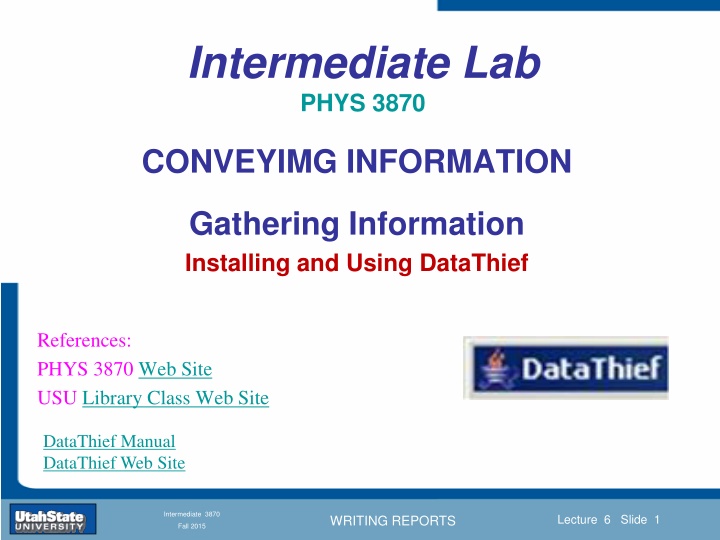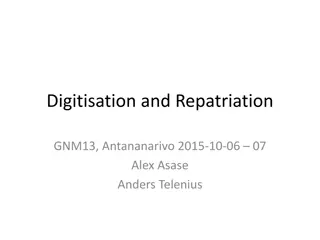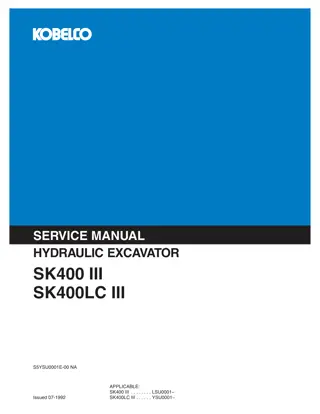DataThief III - Digitizing Data for Analysis
DataThief III is a program designed to digitize data from various sources for plotting and analysis. It is commonly used to extract data from scanned graphs in articles. This tool is user-friendly and freely available. The process involves acquiring and installing the program along with its documentation. DataThief III is written in Java and requires the Java Virtual Machine for operation. Key features include easy data extraction from images, precise coordinate indicators, and a user-friendly interface.
Download Presentation

Please find below an Image/Link to download the presentation.
The content on the website is provided AS IS for your information and personal use only. It may not be sold, licensed, or shared on other websites without obtaining consent from the author.If you encounter any issues during the download, it is possible that the publisher has removed the file from their server.
You are allowed to download the files provided on this website for personal or commercial use, subject to the condition that they are used lawfully. All files are the property of their respective owners.
The content on the website is provided AS IS for your information and personal use only. It may not be sold, licensed, or shared on other websites without obtaining consent from the author.
E N D
Presentation Transcript
Intermediate Lab PHYS 3870 CONVEYIMG INFORMATION Gathering Information Installing and Using DataThief References: PHYS 3870 Web Site Introduction Section 0 Lecture 1 Slide 1 USU Library Class Web Site DataThief Manual DataThief Web Site INTRODUCTION TO Modern Physics PHYX 2710 Fall 2004 Intermediate 3870 Lecture 6 Slide 1 WRITING REPORTS Fall 2015
DataThief DataThief III is program to digitize data in various forms for subsequent plotting and analysis. It is often used to borrow data from scanned graphs in articles. DataThief is a free shareware program and is very easy to use. The presentation includes: Instructions on how to download and install the program and where to get supporting documentation. A detailed set of instruction on how to use the program to digitize data from a picture of a graph. A simple example of acquiring digitized data from a photograph . A simple exercise in use of DataThief is described in the file PHYS 2500 Sec5-Graphing DataThief Exercise.ppt. Introduction Section 0 Lecture 1 Slide 2 INTRODUCTION TO Modern Physics PHYX 2710 Fall 2004 Intermediate 3870 Lecture 6 Slide 2 WRITING REPORTS Fall 2015
Acquiring DataThief III DataThief III is already installed and running on the PHYS 2500 CITRIX page. (1) Go to Datathief.com To acquire and install your own copy of the shareware program DataThief III and its accompanying documentation, simply follow the numbered steps listed here. (2) Review the program Description (3) (Download Java as well, if you need it.) Download the executable program file Datathief.jar by Clicking here (4) Download the manual Introduction Section 0 Lecture 1 Slide 3 (5) Review some examples, if you like. INTRODUCTION TO Modern Physics PHYX 2710 Fall 2004 Intermediate 3870 Lecture 6 Slide 3 WRITING REPORTS Fall 2015
Orientation to DataThief III DataThief III is written in Java. This means, that apart from the "executable" called Datathief.jar, you will have to have the Java Virtual Machine. The Java Virtual Machine can be downloaded from www.java.com. Follow the instructions that are appropriate for your machine. Once the virtual machine is installed, you may start DataThief. On Windows, double click the Datathief.jar icon. On Macintoshes with MacOS 8 or MacOS 9, double click the Datathief application icon. On Macintoshes with MacOS X and on Linux or Unix either double click the Datathief icon, or go to the directory where you installed DataThief and type Datathief. Once you have a running DataThief, select "Open..." from the File menu, and select the file you want to take data from. In this example, we used "example.png . Key features of DataThief are shown below. 3 point indicators used to find the corresponding coordinate indicator tool bar menu bar Start location indicator (green with a + through its center) "Dump", used to define data points Color location indicator (blue with a + through its center) 3 coordinate indicators have an X through there center Introduction Section 0 Lecture 1 Slide 4 Stop location indicator (red with a + through its center) White area with the image in it is the image area INTRODUCTION TO Modern Physics PHYX 2710 Fall 2004 Intermediate 3870 Lecture 6 Slide 4 WRITING REPORTS Fall 2015
DataThief in Action (2) Select an image file using Open from the File menu. Allowed file types include gif, jpg, and png. To use DataThiefIII to digitize data from a graph: (1) Open DatathiefIII. (3) Select whether to digitize a point graph or line graph (4) Define the graph axes by tagging 3 axis coordinate indicators by dragging and dropping the 3 circled X icons onto the axes points and entering the corresponding numerical values. Note: If the 3 axes points are not visible on the graph, select Reset from the Actions menu. Click a colored button (e.g., Ref 0) to flash the corresponding axis point Note: For pictures you can use this to put the digitized values in the correct units if you know the values of these three points. Note: This can correct for skewed axes by selecting non-orthogonal axes. Introduction Section 0 Lecture 1 Slide 5 INTRODUCTION TO Modern Physics PHYX 2710 Fall 2004 Intermediate 3870 Lecture 6 Slide 5 WRITING REPORTS Fall 2015
Setting DataThief Simply follow the remaining numbered steps listed here. (7) Export The data to a file using the File menu (5) Select axes type using the Axis menu (6) To borrow discrete data points, select the Point mode icon and then tag each data point by dragging crosshairs from the Dump on top of the point Introduction Section 0 Lecture 1 Slide 6 (5 Alternate) To borrow data from traces (lines): Select the Trace mode icon, Tag the beginning and end of the trace to steal with the green and red icons, respectively Set the color of the line by dropping the blue icon on a well isolated portion of the trace Use the three point indicators Start , End and Color to locate the icons to drag. The density of data points digitized can be adjusted using the Output Distance selection from the Settings tab. INTRODUCTION TO Modern Physics PHYX 2710 Fall 2004 Intermediate 3870 Lecture 6 Slide 6 WRITING REPORTS Fall 2015
Reading DataThief Txt Files (8) Read into an Excel file as comma delimited text using the Excel Text Import Wizard called up from the From Text icon on the Data ribbon in Excel. Introduction Section 0 Lecture 1 Slide 7 INTRODUCTION TO Modern Physics PHYX 2710 Fall 2004 Intermediate 3870 Lecture 6 Slide 7 WRITING REPORTS Fall 2015























